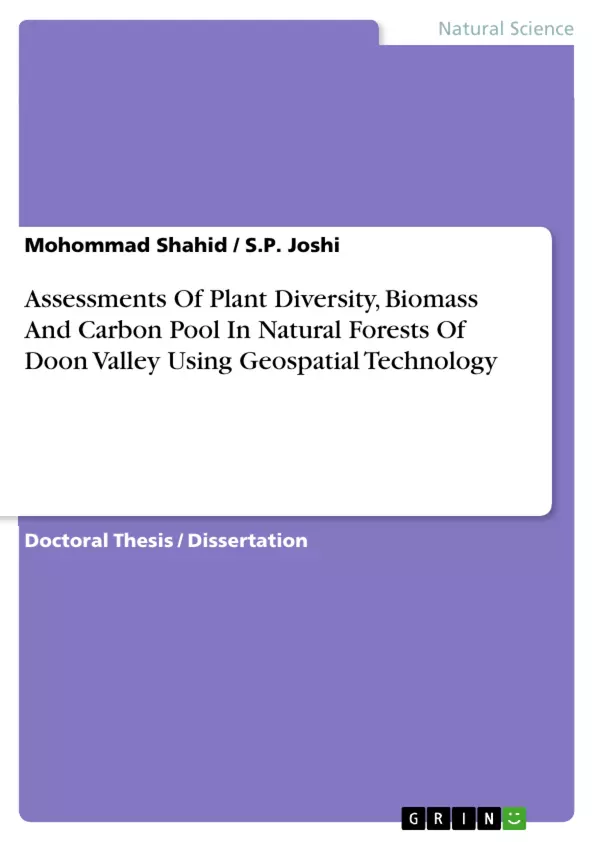Forests are an important natural ‘brake’ on climate change sequester and store more carbon than any other terrestrial ecosystem. The main carbon pools in forest ecosystems are the living biomass of trees and understorey vegetation and the dead mass of litter, woody debris and soil organic matter. The carbon stored in the aboveground living biomass of trees is typically the largest pool. Thus, estimating aboveground forest biomass carbon is the most critical step in quantifying carbon stocks and fluxes from forests.
India is a large developing country known for its diverse forest ecosystems and is also a mega-biodiversity country. Forest ecosystems in India are critical for biodiversity, watershed protection, and livelihoods of indigenous and rural communities. The National Communication of the Government of India to the UNFCC has reported that the forest sector is a marginal source of CO2 emissions. India has formulated and implemented a number of policies and programmes aimed at forest and biodiversity conservation, afforestation and reforestation. All forest policies and programmes have implications for carbon sink and forest management.
A number of studies highlighting carbon stocks of India forests at macrolevel utilizing Remote Sensing & Geographic Information System techniques have gained momentum. However, Carbon stock at micro level is still lacking and in view of this, the present study is an attempt to assess the vegetation, biomass and carbon stock of three ranges of Dehra Dun Forest Division.
Inhaltsverzeichnis (Table of Contents)
- INTRODUCTION
- INTRODUCTION
- CLIMATE CHANGE - THE SCIENTIFIC BASIS
- THE INTERNATIONAL CLIMATE POLICY REGIME
- ROLE OF FORESTS IN THE GLOBAL CARBON CYCLE
- METHODS TO ASSESS CARBON FLOWS OF FORESTS
- CARBON AND IT'S CHANGES
- CARBON SEQUESTRATION AS A CLIMATE MITIGATION OPTION
- REVIEW OF LITERATURE
- FOREST BIOMASS
- THE RELATIONSHIP BETWEEN BIODIVERSITY AND ECOSYSTEM FUNCTIONING
- CARBON SEQUESTRATION AND STORAGE IN FORESTS
- FOREST AND SOIL ORGANIC CARBON
- OBJECTIVES OF THE STUDY
- STUDY SITE
- INTRODUCTION
- DEVELOPMENT OF FORESTS IN DEHRA DUN
- GEOLOGY
- CLIMATE
- SOIL
- VEGETATION
- SOIL
- PLANT DIVERSITY
- ASSOCIATION OF PLANT SPECIES AND THE FOREST STRUCTURE
- BIOMASS CONTRIBUTION AND THE CARBON POOL
- SUMMARY CONCLUSION
Zielsetzung und Themenschwerpunkte (Objectives and Key Themes)
This research aims to assess the plant diversity, biomass, and carbon pool in natural forests of the Doon Valley using geospatial technology. The primary objective is to quantify carbon stocks within the forest ecosystems of three ranges in the Dehra Dun Forest Division: Barkot Range, Lachchiwala Range, and Thano Range.- Plant diversity and species composition within the forest ecosystems.
- The relationship between plant species association and forest structure.
- The estimation of aboveground biomass and carbon pools across different forest types.
- The utilization of remote sensing and geographic information systems for mapping forest types and carbon stocks.
- The role of forests in carbon sequestration and climate change mitigation.
Zusammenfassung der Kapitel (Chapter Summaries)
- Chapter 1: Introduction: This chapter provides a comprehensive overview of the study's context, addressing the significance of forests in carbon sequestration, the impact of climate change, and the role of forests in the global carbon cycle. It also reviews relevant literature, highlighting previous research on forest biomass and carbon sequestration, and outlines the study's objectives.
- Chapter 2: Study Site: This chapter delves into the specific location of the study area, focusing on the Dehra Dun Forest Division, including its geological history, climatic conditions, soil characteristics, and vegetation patterns. It discusses the development of forests in the region and their ecological importance.
- Chapter 3: Soil: This chapter examines the physical and chemical properties of the soil within the study area. It presents data on soil organic carbon content, which is crucial for understanding the role of soil in carbon sequestration.
- Chapter 4: Plant Diversity: This chapter explores the rich diversity of plant species found within the study area's forest ecosystems. It analyzes the composition and distribution of different plant species, contributing to the understanding of the overall biodiversity.
- Chapter 5: Association of Plant Species and the Forest Structure: This chapter investigates the relationships between different plant species and how they contribute to the overall structure of the forest ecosystems. This analysis helps determine the dominant tree species and their influence on the forest's overall health and stability.
- Chapter 6: Biomass Contribution and the Carbon Pool: This chapter focuses on quantifying the aboveground biomass of different forest types within the study area. It estimates the carbon pool associated with these biomass estimates, providing crucial insights into the overall carbon sequestration potential of the forests.
Schlüsselwörter (Keywords)
The study focuses on the assessment of plant diversity, biomass, and carbon pool in natural forests of the Doon Valley, utilizing geospatial technology. Key terms and concepts include: forest ecosystems, biodiversity, carbon sequestration, biomass, carbon pool, remote sensing, geographic information systems, climate change mitigation, forest management, and the Dehra Dun Forest Division. This research contributes to our understanding of the role of forests in mitigating climate change and highlights the importance of sustainable forest management practices.- Arbeit zitieren
- Dr. Mohommad Shahid (Autor:in), Dr. S.P. Joshi (Autor:in), 2013, Assessments Of Plant Diversity, Biomass And Carbon Pool In Natural Forests Of Doon Valley Using Geospatial Technology, München, GRIN Verlag, https://www.grin.com/document/284629



